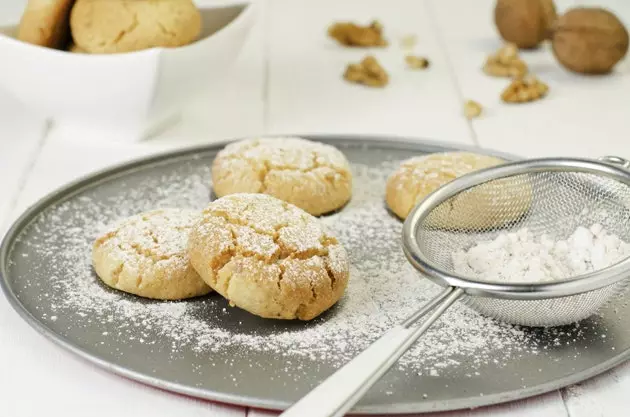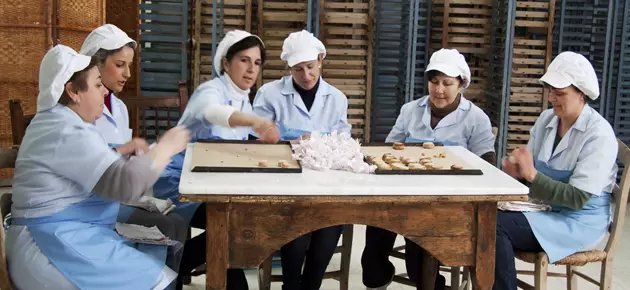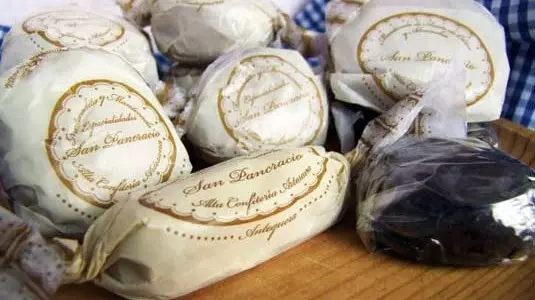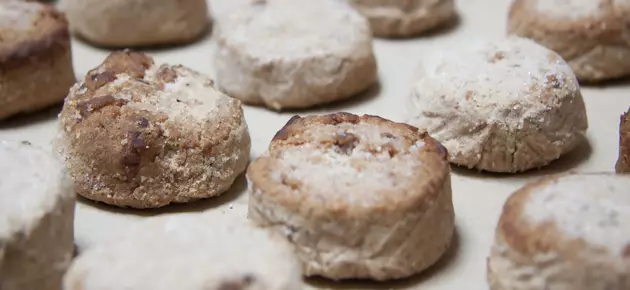
Enough cupcakes!
A handful of things that remind us that Christmas is here: Norman Rockwell's turkeys , the thousands of light bulbs on the Gran Vía (a magnet for so much hair from the Dehesa), the nativity scene in the Puerta de Alcalá, the background music in El Corte Inglés, Love Actually, the Cascajares capon, the spot for "the bubbles" , the carols of Raphael, Mariah Carey and Wham (watch out for the glam trident: Raphael, Mariah Carey and Wham) but, above all, the nougat, the marzipan and the Polvorones.
The destroyer trio of the Holidays. The arid challenge of true enjoyment **( Polvorones without liters of water: certain death) ** an immensely pleasant experience (how not to be: lightly baked butter, almonds, flour and sugar) capable of turning your throat into the Arizona desert, an abandoned highway in the apocalyptic universe of Mad Max—but what does it matter when every bite is a caress of Rachel Weisz in front of a fireplace , in an abandoned mountain cabin (it's snowing outside) with nothing to eat but wild truffles, grilled turbot (Rachel loves to cook), and a couple of boxes of Jacques Selosse Substance. That's right, I like the shortbread.
Let's speak clearly. We are a bit up to the mark in the face of so much kitsch with cupcakes, muffins and even the panettone... those candies are not ours! So enough of colorinchis and icing sugar, let the Castilian sobriety of the Polvorón wrap us with its gastronomic roundness.

The sweet castizo par excellence
'APOTHEOSIS OF THE CONFECTIONERY'
A little history. to get started shortbread or shortbread? Let's see: mantecados are all —that sweet made with flour, lard and sugar whose origin dates back to Andalusia (there is a debate between Antequera and Estepa) of the 16th century, during the reign of King Felipe II and thanks to a surplus of both wheat like lard. One note: Jose Maria Peman , member of the Royal Academy of the Spanish Language, in 1944, in his book "Felipe II in El Escorial", he defined this "flagship" of confectionery, as the "apotheosis of confectionery".
We call Polvorón a variant of the mantecado, a definitive variant: the almond. A more or less common change is also the shape, in the case of the more rectangular ice cream; more oval the Polvorón: the exact and perfect shape to squeeze it very hard in our hand and give it that peculiar shape, so customised… no two shortbreads are the same!
THE ESSENTIALS
** Two Brothers in Castuera (Badajoz) **
Castuera, land of turroneros. It is not known for sure when and with whom it was introduced among the Castueranos (aha) but there is talk of Romans, Arabs, Christians and muleteers: nougat and butter sweets as food for walkers in Extremadura . We like to imagine a mountaineer from Extremadura with his little bag of shortbread, right? Probably my top Polvorones, my perfect Polvorón.
**San Pancracio in Antequera (Malaga) **
Due to its large number of convents, **Antequera has traditionally been a city of high artisan confectionery (they have to do something) **. In Horno San Pancracio they make the mantecados in a completely traditional way and with (pay attention to this fact, which is definitive) extra virgin olive oil from the area and whole almonds. Absolutely familiar and handmade, we really like San Pancracio.

We really like San Pancracio
** The Mattress in Estepa (Seville) **
The Polvorón whose fame reached the New York Times and —as they affirm and demonstrate with this document: the oldest house in Estepa . Let Don Antonio Burgos speak: It had to be a woman from Estepa who made them universal. The wife of the Estepa cosario, Micaela Ruiz Téllez, who was called "La Colchona", by the nickname of her nursemaid. This woman, born in 1824 and died according to some sources in 1901 and in 1904 according to others, took advantage of the visits to Córdoba of her husband the cosario to sell there the homemade sweets that they made in the town with the lard of the pig from the slaughter . They say that La Colchona put the mantecado estepeño , perishable beauty, roadworthy without hardening her: she dried it out so it would have no "heart" and stay tender. The rest, according to art: flour and sugar.

MMM...
** King Felipe II (Alava) **
One of the most popular among gourmets with fine peaks . Made by Blancanieves Tejedor confectionery, they do not move a millimeter from the classic recipe for the sweet born in our Golden Age: of wheat flour, sugar, Marcona almond flour and butter . The King Felipe II are the shortbread that probably receive the most awards, for example the Gold Star for flavor awarded by the International Taste & Quality Institute of Brussels (considered the Michelin Guide to Food and Drinks) in 2013 and 2014. And I ask , what the hell will Brussels know about butter and shortbread? But that is another story...
Obrados Fish, in Toledo
Today we have talked a little about that other Christmas delicacy so mistreated by fashion bloggers and runners: the marzipans . In Mazapanes Peces (a small family bakery located in the Toledo town of Consuegra) They have been making marzipan since 1915 in an absolutely traditional way. And not only marzipan, but also a wonderful shortbread made with toasted almonds with which we pay tribute to all your nose detox diets.
**Polvorones el Toro Vega, in Tordesillas (Valladolid) **
eye what they are the fifth generation of artisans dedicated to Christmas sweets . Founded by Fermín Galicia, his sons Amador Galicia and Emilia Sigüenza took over in the 1950s and made Toro de la Vega Polvorón known in many small pastry shops in post-war Madrid. Maybe (for this reason) one of the most beloved Polvorones by the people of Madrid , so present in “grandma's pantry”.
** The Pantry of the Palace in Estepa (Seville) **
Every year they are made in Estepa (Seville) more than twenty million kilos of this "confectionery apotheosis". One of the most traditional workshops is that of Antonio Santaella (La Pantry of the Palace) in whose palatial oven he began to work in 1743. The rest is history: “It would not take long for Dª Luisa to make him responsible for the palace pantry as well, of the hand of the famous Don Juan Martínez de Baños, who would come, years later, to the position of Gentleman of the Mouth of King Carlos III, when his lord, Don Juan Bautista Centurión, was granted the key of Gentleman of the Chamber of the Royal House” .
Merry Christmas.
Follow @NothingImporta
*** You may also be interested in...**
- European desserts for Christmas
- The best roscones de reyes
